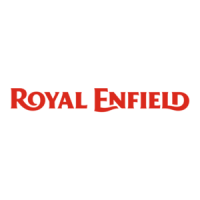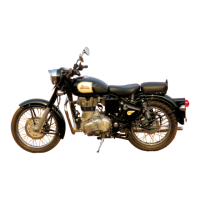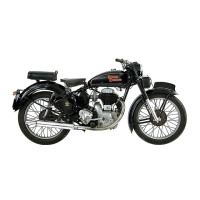
Do you have a question about the Royal Enfield Bullet 350cc and is the answer not in the manual?
| Displacement | 346 cc |
|---|---|
| Max Power | 19.1 bhp @ 5250 rpm |
| Max Torque | 28 Nm @ 4000 rpm |
| Fuel System | Fuel Injection |
| Front Suspension | Telescopic, 35 mm Forks, 130 mm Travel |
| Rear Suspension | Twin shock absorbers with 5-step adjustable preload |
| Fuel Capacity | 13.5 liters |
| Seat Height | 800 mm |
| Wheelbase | 1370 mm |
| Ground Clearance | 135 mm |
| Engine Type | Single Cylinder, 4 Stroke, Air Cooled |
| Transmission | 5-speed |
| Front Brake | Disc |
| Rear Brake | Drum |
Points to observe during dismantling and reassembly for safe riding.
Advice on ordering spare parts from official dealers and required information.
Routine maintenance is a continuous process for keeping the machine in peak condition.
Essential daily checks for mechanical and safety aspects of the motorcycle.
Monthly maintenance tasks including oil levels, contacts, and brake adjustments.
Tri-monthly service operations including plug, timing, and carburetor checks.
Six-monthly service includes oil changes, filter checks, and steering head bearing inspection.
Detailed technical specifications for the 350cc engine components and performance.
Specifications for the 350cc gearbox, including gear ratios and bearing types.
Details on front and rear suspension types and stroke for the 350cc model.
Specifications for front and rear brake systems, including shoe types and dimensions.
Fuel tank capacity and reserve capacity information for the 350cc model.
Details on oil capacity and recommended grades for various components.
Physical dimensions of the 350cc motorcycle, including weight and clearance.
Electrical system specification, typically voltage.
Detailed technical specifications for the 500cc engine components and performance.
Specifications for the 500cc gearbox, including gear ratios and components.
Details on front and rear suspension for the 500cc model.
Specifications for front and rear brakes on the 500cc model.
Fuel tank capacity and reserve capacity for the 500cc model.
Oil capacity and grade specifications for various parts of the 500cc model.
Physical dimensions of the 500cc motorcycle, including weight and clearance.
Electrical system specification for the 500cc model, typically voltage.
Detailed list of engine components and their identification numbers.
Procedure for removing carbon deposits from engine valves, ports, and combustion chamber.
Steps to disconnect and remove the petrol tank from the motorcycle.
Procedure for disconnecting components and lifting the cylinder head off the engine.
Steps to remove the cylinder barrel and piston assembly.
Procedure for removing valves, springs, and associated components from the cylinder head.
Cleaning carbon deposits from valves, ports, and combustion chamber, avoiding aluminium damage.
Guidance on fitting piston rings, checking wear, and specifications for 350cc models.
Examining the condition and end float of the big end bearing.
Inspection for wear on valve stems, guides, and checking valve spring lengths.
Maintenance and operation of the decompressor mechanism.
Steps for reassembling the engine after decarbonising, with warnings on parts and torque.
Procedure to remove the timing cover, noting oil escape and crankcase cranking.
Cleaning and replacing the oil filter element and feed/return filters.
Steps for overhauling the oil feed and return pumps, including disc and plunger checks.
Procedure to remove the pump worm and timing pinion using special tools.
Steps to remove the contact breaker housing, base plate, and shaft.
Procedure for setting engine valve timing using punch marks on cams and pinion.
Adjusting tappet clearance when the engine is cold for optimal performance.
Details the differences in clutch plates between the 350cc and 500cc models.
Steps for removing the clutch assembly, including sprockets and chain.
Procedure to remove engine and clutch sprockets for primary chain access.
Steps to remove the final drive sprocket, including tensioner and chaincase.
Correct order for reassembling clutch plates, friction plates, and springs.
Adjusting the primary chain tensioner pad and checking chain length.
Adjusting clutch cable free play at the gearbox and handlebar for proper operation.
Instructions for fitting the alternator stator and rotor, including air gap specifications.











